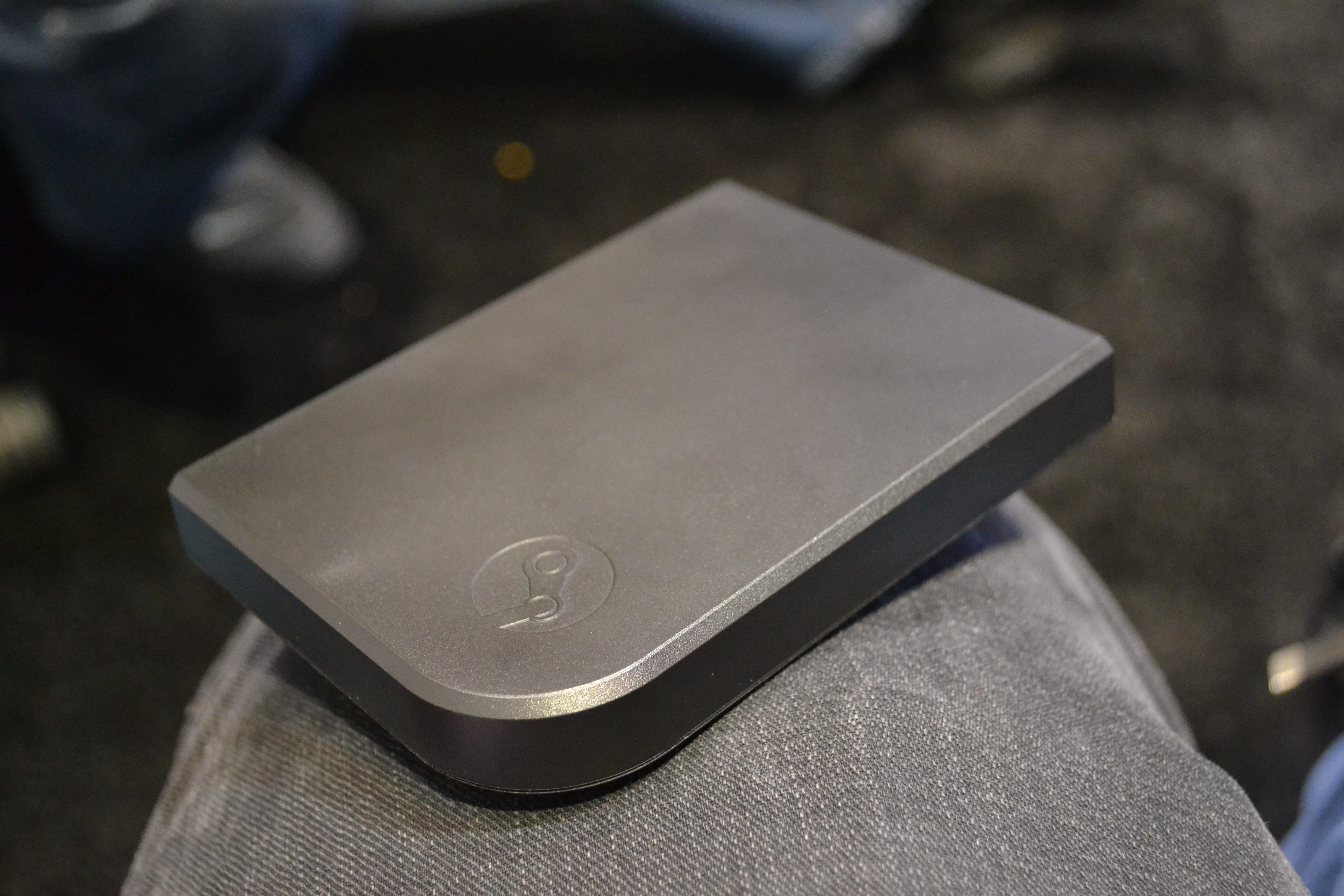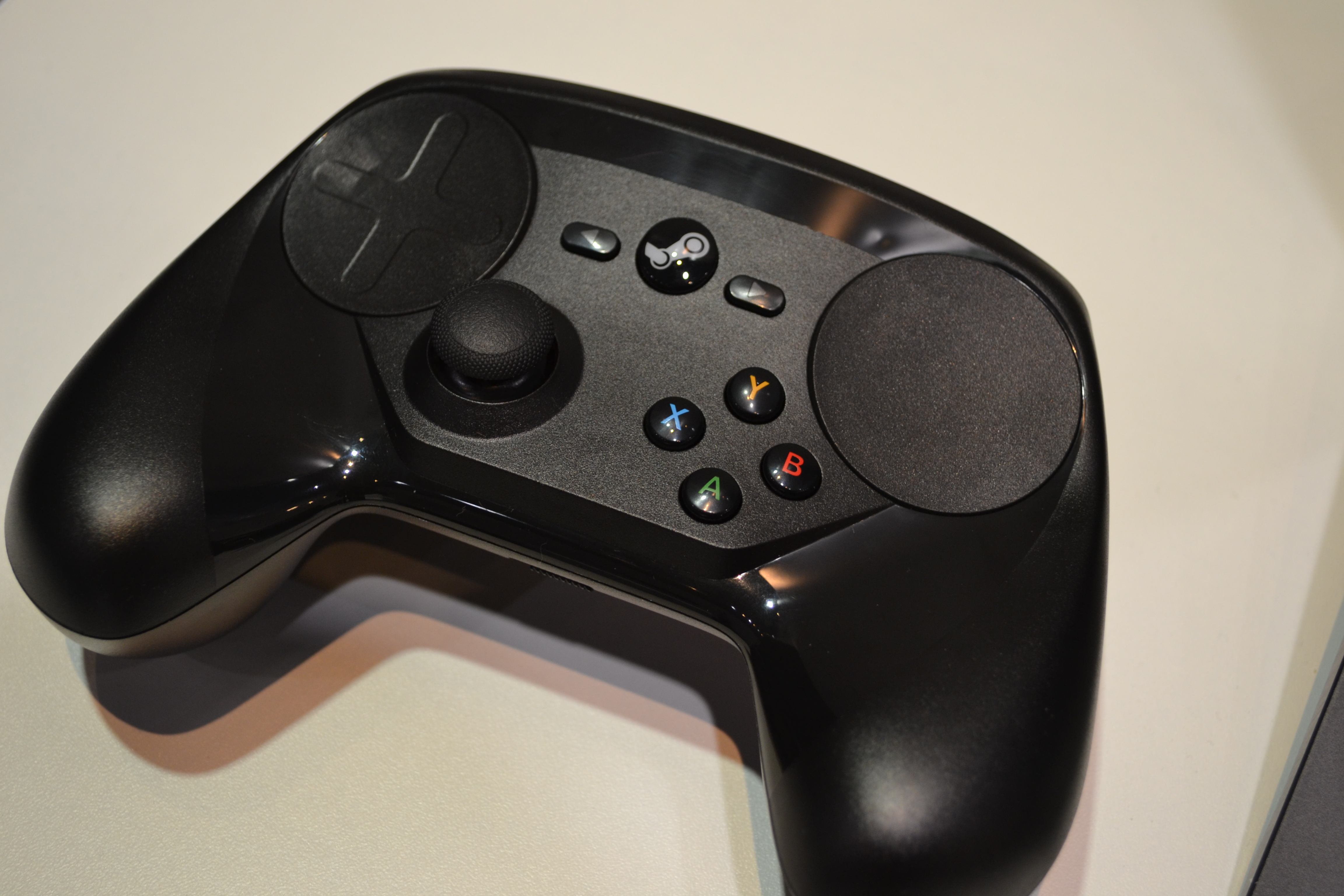Valve's Steam Controller And Steam Link: Huge Potential, Underwhelming Prototypes
At GDC we had a chance to look at prototypes for two new products coming from Valve, the Steam Controller and the Steam Link.
Steam Link
The details on this device are still a little mysterious. There are three USB ports, an RJ-45 connector, and a place for a Wi-Fi antenna, which is expected to use the latest 802.11ac standard. HDMI is used to connect to a display.
Steam Link works to link your home PC to another display through your home network, so you can play games from your Steam library that are installed on that PC.
If you have read about Nvidia's latest Shield device, they are similar in that they are both home game consoles that have the game processing done somewhere else, be it a server or your home PC. NZXT's Doko is more closely related to the Steam Link device in that it simply mirrors your PC, which is what Steam Link does, but Steam Link is currently more limited in what it can mirror.
The Steam Link and NZXT Doko have an advantage over the Nvidia Shield, because they run over your home network, and an Internet connection may not be required at all. Nvidia Shield has the advantage of being able to do substantially more without a PC, and because games are processed on a server, the video settings for games could be significantly higher if your PC cannot run games with maxed-out settings.
The Steam Link is easy to set up -- it just needs to be connected to the network -- but I can't help but feel that there is wasted potential for the device. To play a game with Steam Link, you need to physically start a game on the PC, then go to where the Steam Link is and play the game. The device mirrors the PC, but it only does this after the game launches. You cannot just start the game remotely from the Steam Link.
I asked Gabe Newell, founder and president of Valve, if it is possible to control your computer with Steam Link for other purposes, such as Web browsing or watching a video. Newell said that it is technically possible, but Valve had no plans to use the device for this purpose. Newell did say, however, that OEMs who license the technology for embedding into other devices could develop this feature later on.
Get Tom's Hardware's best news and in-depth reviews, straight to your inbox.
The potential to have a single very fast computer in your house, and then numerous Steam Link devices connected to it for multiple purposes, would be extremely useful, as it would remove clutter and potentially reduce costs compared to buying multiple devices for those purposes.
We were told that Valve hopes that display manufacturers will integrate Steam Link into their products, which would further reduce clutter. Imagine all the game systems, DVD players, media players, DVR, or other devices that could potentially be reduced down to a single embedded device in your display that connects to a PC.
For now, when Steam Link comes out in November, it is expected to run at 1080p with a 60 Hz refresh rate.
Steam Controller
Valve also demonstrated a version of the Steam Controller with Steam Link. Steam Link has a sensor to send the controller input back to the PC through the network so that it can work in other rooms besides the one with the PC.
When using the controller to play a pre-alpha version of Unreal Tournament, the game itself didn't seem to have problems, but the controls were flawed.
Trying to look around using the right touchpad was a terrible experience. The best way I can describe it is to imagine using an old, heavy, low-DPI ball mouse and playing a game. You need to keep picking up the mouse to try and look around, and the in-game action is happening too fast for it to really work effectively.
It's possible that this is a programing issue with the game and the controls, but walking and firing worked perfectly, so I tend to think that the controller was the problem. Because this is a prototype of the controller, it's possible that this is a problem that will be fixed over time.
The products Valve showed us at GDC were interesting and offer plenty of potential when they come out later this year. Unfortunately, though, they're still under development, so it's impossible to know all the details of these devices at this time. Both should be out by November of this year, when we'll look forward to comparing this experience with the finished products.
Follow us @tomshardware, on Facebook and on Google+.
-
Grognak I thought the touchpad worked sort of like a joystick i.e. different speeds the further you go from the center - the larger area would've offered better accuracy, a good middle ground between joystick and mouse. If it works like a laptop touchpad I can't imagine what kind of games would benefit from it. Bad move, Steam.Reply -
fern4all they should make the right pad an actual track ball that would be cool and of course more responsive.Reply -
Maddux "To play a game with Steam Link, you need to physically start a game on the PC, then go to where the Steam Link is and play the game. The device mirrors the PC, but it only does this after the game launches. You cannot just start the game remotely from the Steam Link."Reply
I think that's wrong. That's not how Steam's In-Home-Streaming works right now, so why would their dedicated box work that way? I think you've got some bad information. -
qlum I think valve should have gome for a double air mouse type controller as it offers more flexibility and also would work better with vr in the future but that's just meReply -
raudi The article has to be corrected and expanded in a few places.Reply
1. The NVIDIA SHIELD devices can also stream in home from your computer if you have a GTX.
2. The NVIDIA is running Android TV and has significantly more powerful hardware and can also run any Android game on the device itself. Even Crysis 3 was ported to it (how good or bad is another discussion)
3. Since the Steam Link is basically a low power Linux system running Steam OS, it would surprise me if it can't launch games remotely since if memory doesn't deceive me, I did exactly that on a Linux system with the steam client months ago. It even let me decide if I wanted to run it remotely or locally. So you don't have to start the games on the PC and don't have to get up from your couch.
4. You can simply add a web browser to your steam library and stream it that way. This at least works for me with the NVIDIA in home streaming and Limelight on Android, so I would expect it to work with the Steam streaming as well
5. A Sensor for the controller? Don't you mean a wireless receiver? -
quilciri I'm not sure what Mike was expecting here, but I liked the new prototype. No, it's not as accurate as a gaming mouse, but it's significantly faster and more accurate than an analog stick.Reply -
Merry_Blind Seems like the issue with the controller could have been solved just by changing the sensitivity of it either in-game or in the controller options.Reply
Also, did it function like how Grognak described or like a regular laptop touch pad?
And what about the haptic feedback? Is it still a feature of the controller? Does it feel nice? -
TechyInAZ I like the streaming idea. But that steam controller is weird, no joystick? Are they trying to turn the controller into a hybrid mouse/controller? (Good idea, but hard to make work.)Reply -
quilciri Yes, they kept the haptic feedback. It feels like you're thumbing a trackball that's bigger than what could fit in the controller. You can "fling" it like a trackball as well.Reply
I'd like if they swapped the right trackpad position with where the face buttons are now, though.

